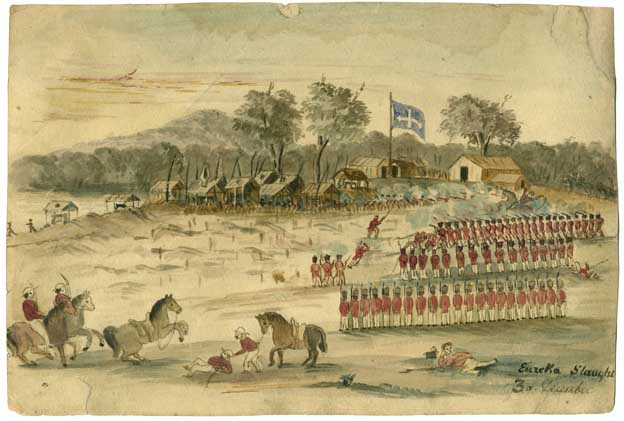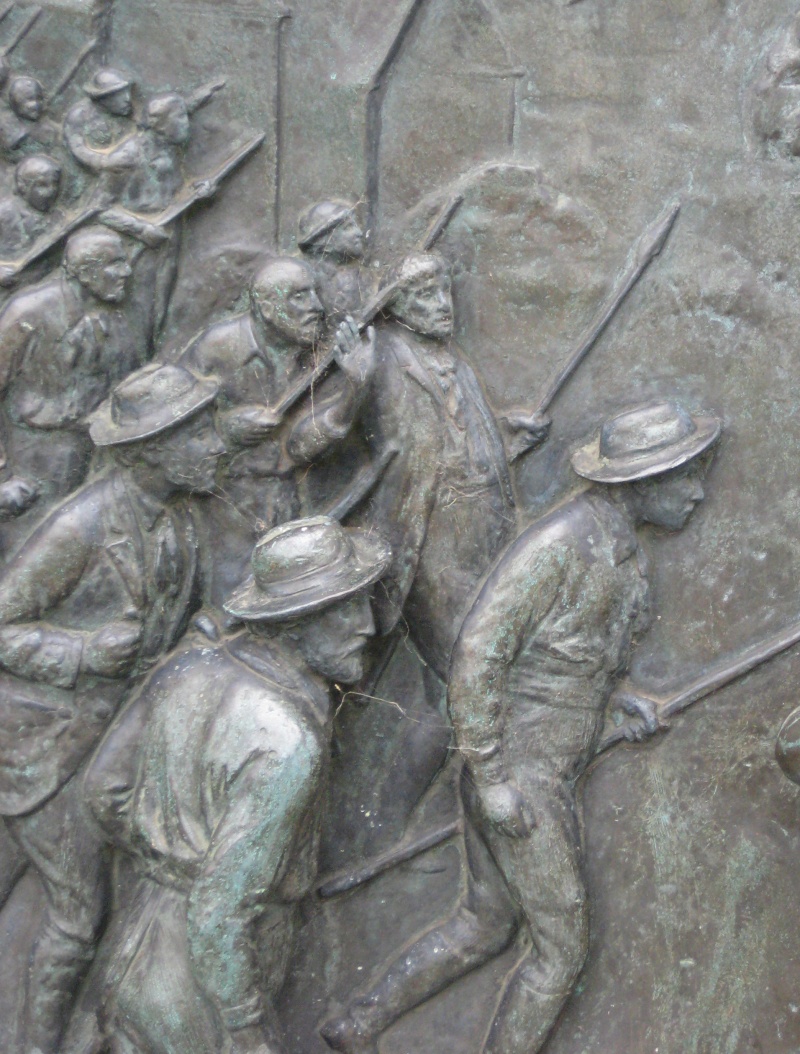Pikemen
- ...Raphaello made a speech. He said— "Gentlemen soldiers, those that cannot provide themselves with firearms, let them provide themselves with a piece of steel, if it is only six inches long, attached to a pole, and that will pierce the tyrant's heart." He marched his men to Eureka, and drilled them there on that and the following day. ...[1]
- Drilling proceeded vigorously. Blacksmiths hammered away at pikes - rude weapons like a billhook fastened on the end of stringy-bark saplings. The stockade, a rough barricade, enclosing about an acre of ground, on the Eureka lead, behind where the Orphan Asylum now stands, was made Lalor's headquarters. The barricade was a flimsy affair, constructed of slabs stuck on end, brush wood, and whatever could be obtained handy. It enclosed several tents, stores, and windlass claims, and appears to have been designed to conceal the operations of the head quarters staff rather than as a fort, in spite of Lalor's untiring efforts it it was difficult to enforce discipline. Men came and went freely, and all that happened was known to the commissioner. The diggers knew that another large reinforcement of troops from Melbourne was expected, and they believed they were secure until these arrived. [2]
The following were known to be Pikemen at Eureka
- Arthur Arnold; Bryant; Patrick Curtain; Thomas Dignum; William Emmermann; Michael Hanrahan; John Joseph; John Lynch; John Manning; Patrick O'Day[3]; Henry Sutherland; Edward Thonen;
Pikeman's Dog
The RSPCA Purple Cross Award was presented to the Pikeman's Dog posthumously at the Ballarat Fine Art Gallery on 30 November 1997. The ceremony took place in front of the original Eureka Flag that the Pikeman died defending at Eureka Stockade in 1854. Detective Sergeant Peter Lalor, the great-great-grandson of Peter Lalor the leader of the diggers at Eureka Stockade accepted the award on behalf of the Eureka trust.[4]
The Pikeman's Dog, a little terrier, showed great devotion and bravery at the death of his master at the Eureka Stockade on 3 December 1854. As a result of the attack on the miners by Crown forces, five British soldiers and some thirty miners died. Among the miners lay a Pikeman, mortally wounded with some 15 wounds. Guarding his body throughout the hours it lay unclaimed at the battlefield, and later accompanying it on the death cart as the remaining bodies were transferred to the cemetery, was this little companion. This was the Pikeman's Dog.[5]
The RSPCA Australia Purple Cross Award recognises the deeds of animals that have shown outstanding service to humans, particularly if they showed exceptional courage in risking their own safety or life to save a person from injury or death.[6]
The Award was named to honour the Purple Cross Society which was established soon after the outbreak of World War I to raise funds for the supply of gear and veterinary treatment for the Light Horse Brigade. The Purple Cross Society was disbanded in 1971 and the RSPCA in Victoria was charged with preserving and displaying the flag of the Society, which now hangs in the Council Room of the RSPCA Victoria headquarters. As a tribute to the memory of all of Australia's war horses, the RSPCA Australia exceptional animal award is known as the Purple Cross Award. Recipients of the Purple Cross Award receive a Purple Cross medal and a certificate.[7]
An unpublished diary makes reference to William Emmermann as the pikeman whose terrior would not leave his side after Emmerman’s death, although according to Peter Lalor the pikeman could have been Edward Thonen.
- A REMINISCENCE OF EUREKA
- To the Editor.
- Sir,-Perusing your Saturday's issue I was very much interested in your narrative of the Eureka riot, especially the incident referring to the little terrier dog, to which I am desirous of adding my testimony as to its correctness.
- Upon that fatal Sunday morning, when the strife was practically over, I visited the scene. I saw eleven bodies lying upon the ground, to be recognised by relatives or friends Some had been taken away before my ar rival. I saw the little terrier whining piteously beside his dead master. While viewing this solemn scene a dray arrived in which was placed the body of the man who in life was the owner of the dog. When the little dog saw his master removed, his grief knew no bounds. Those interested tried to drive him away: they could not beat him back. He got into the dray and sat upon his master's breast, revealing in most unmistakable language that his master was taken from him. No human being could have lamented more at the loss of their dearest relative or friend than that affectionate and faithful dog be wailed the loss of his master. Though fifty years have passed away, this pathetic scene is vivid in my memory as though it occurred yesterday. It is one of those scenes which time cannot efface. I am etc.,
- CHRISTOPHER CROOK.
Mrs Bath exhibited a pike used at the Eureke Stockade, found by her on the morning after the battle. It was exhibited during the 1876 Ballaarat Mechanics' Institute Fine Arts Exhibition.[8]
Also See
References
- ↑ The Argus, 11 December 1854.
- ↑ Charleville Times, 31 December 1904
- ↑ The Argus, 11 December 1854.
- ↑ http://www.rspca.org.au/what-we-do/awards/rspca-purple-cross-award.html, viewed 12 May 2013.
- ↑ http://www.rspca.org.au/what-we-do/awards/rspca-purple-cross-award.html, viewed 12 May 2013.
- ↑ http://www.rspca.org.au/what-we-do/awards/rspca-purple-cross-award.html, viewed 12 May 2013.
- ↑ http://www.rspca.org.au/what-we-do/awards/rspca-purple-cross-award.html, viewed 12 May 2013.
- ↑ Ballaarat Mechanics' Institute Fine Arts Exhibition 1876 Catalogue.



